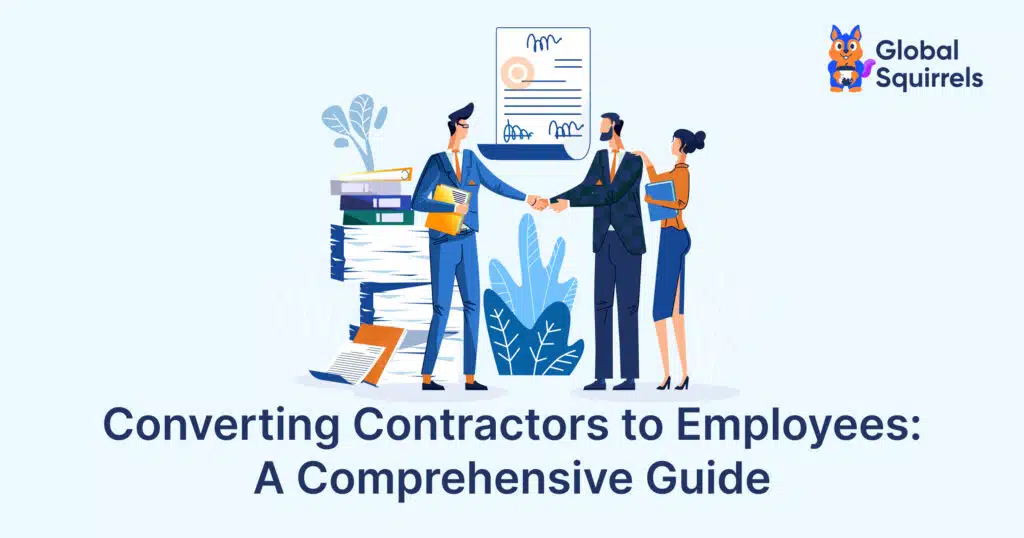Converting Contractors to Employees: A Comprehensive Guide

Imagine a world where a graphic designer in Buenos Aires and a software developer in Bangalore are as integral to your team as your local employees. This is the reality of our interconnected digital era, where businesses are not just exploring but embracing the global talent pool. Often, this journey starts with hiring international contractors, offering flexibility and scalability. Yet, as these professional relationships evolve, the process of converting contractors to employees becomes a strategic imperative, deepening their integration into the team.
Enter Global Squirrels, your PEO/EOR compass, guiding you through this crucial journey. Our comprehensive guide demystifies and simplifies this transition, ensuring your global workforce is not just diverse but also well-integrated and legally compliant.
Understanding the basics: Contractors vs. Employees
When we think about the people who work for us, they usually fit into two groups: contractors and employees. Understanding these two types is crucial, especially when you’re thinking about changing a contractor into an employee.
Contractors: The solo players
Contractors are like solo artists in the world of work. They run their own show, dealing with their taxes and managing their own time and tools. Think of them as guests who help you out with specific tasks or projects. They have their own way of doing things and are not tied down to just one company.
For your business, contractors are great when you need special skills for a short time. You don’t have to worry about giving them extra benefits like health insurance, which can save money. But, you also can’t tell them exactly how to do their job — you’re hiring them for the results they can deliver, not to be a regular part of your team.
Employees: The team members
Employees are like the core members of your business team. They follow your schedule, stick to your company rules, and their jobs are more about the big picture than just one task. You have a say in how they work and can train them to fit your business just right.
Hiring employees means you’re investing more than just a paycheck. You also provide benefits and take care of their taxes and insurance. In return, employees usually feel more connected to your business and are often more committed.
Also Read: Differences Between Independent Contractors and Employees?
Why convert contractors to employees?
Deciding to switch contractors to full-time employees is a significant move. Here’s why many businesses choose to make this transition:
1. Legal compliance: Avoiding costly mistakes
One of the most important reasons is staying on the right side of the law. Misclassifying someone who should be an employee as a contractor can lead to serious legal trouble and big fines. It’s not just about how you see the role, but how the law does. For example, if a contractor works like a full-time employee but doesn’t get the same benefits, that’s a problem. Staying compliant means classifying your workforce correctly.
2. Business growth: Building a strong foundation
When your business is growing, you need people who are fully invested in its success. Employees, compared to contractors, often bring more dedication and stability to your projects. They understand your long-term goals and are integral to your company culture. This deep involvement can drive your business forward in ways that a short-term contractor relationship might not.
3. Employee loyalty: Cultivating a committed workforce
Turning a contractor into a full-time employee can significantly boost their loyalty to your company. This commitment often translates into lower turnover rates, higher job satisfaction, and better team dynamics. Loyal employees are more likely to go the extra mile for your business, leading to improved performance and productivity.
4. Access to full-time benefits: Attracting top talent
Many workers prefer full-time positions for the security and benefits they offer, like health insurance, paid leave, and retirement plans. By offering these perks, you’re not only looking out for your employees’ well-being but also making your company more attractive to top talent. People often look for jobs that offer more than just a paycheck, and these benefits can be a significant draw.
Also Read : 9 Benefits Of Hiring Independent Contractors for Your Business
Converting contractors to employees: A detailed roadmap
Transitioning contractors to full-time employees involves careful planning and execution. Here’s how to navigate this process effectively:
Step 1: Evaluate the need for conversion
Before anything else, determine if converting a contractor to an employee is necessary. This step involves a close examination of the individual’s current role and their integration within the team. Consider questions like:
- Does their work resemble that of your full-time employees?
- Are they deeply involved in core business operations?
- How essential is their role in the long-term strategy of your company?
If the answers point towards a more permanent and integral role, it might be time to consider conversion.
Step 2: Communicate and document
Open, clear communication is key. Once you’ve decided to move forward, discuss this transition with the contractor. Transparency about the changes in role, expectations, and benefits is crucial. Follow up this conversation with a formal written agreement. This document should cover:
- Job responsibilities
- Salary and benefits
- Working hours and company policies
- Termination conditions
This step not only ensures both parties are on the same page but also serves as critical legal documentation.
Step 3: Adjust legal and payroll frameworks
Converting contractors to employee status means altering the legal and financial relationship. This involves:
- Setting up payroll: Include the new employee in your payroll system, ensuring compliance with tax withholdings and benefits.
- Adjusting legal status: Update contracts and employment records in accordance with labor laws.
- Implementing benefits: Include health insurance, retirement plans, and other employee perks as applicable.
This step is vital for legal compliance and demonstrates your commitment to their new status.
Step 4: Onboarding and integration
Effective onboarding is crucial for integrating your new employee into the company. This process should:
- Familiarize them with the company culture and policies.
- Introduce them to their team and other key staff members.
- Provide training on new tools, software, or processes they need to know as an employee.
A thorough onboarding experience helps smooth the transition and sets them up for success in their new role.
Step 5: Ongoing support and development
Finally, ensure that your newly converted employees receive continuous support and opportunities for professional growth. This involves:
- Regular check-ins to address any concerns or challenges.
- Career development plans, including training and upskilling opportunities.
- Performance reviews to provide feedback and discuss future goals.
By investing in their ongoing development, you not only bolster their job satisfaction but also enhance their contribution to your company.
Global Squirrels: Simplifying international conversion of contractors to employees
Our Employer of Record platform, Global Squirrels, streamlines the conversion process. We manage legal complexities and ensure seamless transitions.
1. Legal compliance
We navigate the complexities of international employment laws, ensuring your conversions are legally sound.
2. Payroll and benefits management
Global Squirrels handles payroll intricacies, accommodating different countries’ tax and benefit requirements.
3. Continuous support
We offer ongoing support for both employers and employees, fostering a smooth and supportive working relationship.
In-depth benefits of conversion with Global Squirrels
1. Streamlined administrative processes
Our platform minimizes paperwork and administrative burdens, making the transition smoother.
2. Cost-effective solutions
By handling legal and payroll complexities, our staffing platform cuts down potential legal costs and fines associated with misclassification.
3. Enhanced employee experience
A well-managed transition enhances the overall experience for your new employees, promoting a positive workplace culture.
Navigating challenges to convert contractor to employee
The transition from contractor to full-time employee is not without its challenges. Understanding and addressing these obstacles is crucial for a smooth conversion process. Here’s a more in-depth look at the primary challenges and how to navigate them:
1. Legal hurdles
Different countries have distinct employment laws, which can make the conversion process complex, especially for businesses operating internationally. Global Squirrels, with its expertise in global employment landscapes, can be instrumental here. We provide:
- Up-to-date knowledge of local labor laws in various countries.
- Assistance in ensuring compliance with employment and tax regulations specific to each region.
- Support in drafting and reviewing contracts that meet legal standards globally.
By leveraging our expertise, your business can confidently navigate the complexities of international employment law, ensuring a legally sound conversion process.
2. Cultural adaptation
Converting contractors to employees can also involve significant cultural shifts, particularly for global teams. At Global Squirrels, we understand the nuances of cultural integration and offer tailored support:
- Cultural sensitivity training to help your team understand and respect diverse work cultures.
- Programs to facilitate smooth communication and collaboration among team members from different cultural backgrounds.
- Initiatives to foster a sense of belonging and inclusion for new employees, regardless of their location.
Our aim is to ensure that your newly converted employees feel comfortable and valued in your organization’s unique cultural milieu.
3. Maintaining contractor flexibility
One of the advantages of contractors is their flexibility. Companies often worry that hiring full-time employees might reduce this operational flexibility. Global Squirrels addresses this concern by:
- Offering strategic guidance on creating flexible work arrangements for full-time employees, such as flexible hours or remote work options.
- Advising on project management and team structure that allow for agility and adaptability, akin to working with contractors.
- Implementing tools and technologies that facilitate flexible work while maintaining productivity and team cohesion.
Our strategies help ensure that transitioning to a full-time workforce does not mean sacrificing the flexibility that contractors provide, thus maintaining a dynamic and adaptable business model.
Future-proofing your workforce with Global Squirrels
As the world of work evolves, staying ahead in managing your workforce is crucial. With Global Squirrels, ensure your team is not only compliant with current regulations but also poised for future growth and challenges.
Conclusion
Transitioning from a contractor to an employee model is a significant step for any business. It’s not just about compliance; it’s about building a resilient, dynamic, and cohesive team. With Global Squirrels, navigate this journey with confidence, backed by expertise, technology, and a commitment to your business’s success.
Your guide to converting contractors to full time employees ends here, but your journey with Global Squirrels is just beginning. Explore how our platform can transform your workforce management today.


